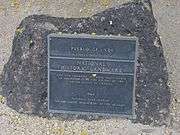Pueblo Grande Ruin and Irrigation Sites
Pueblo Grande Ruin and Irrigation Sites are pre-Columbian archaeological sites and ruins, located in Phoenix, Arizona. It includes a historic platform mound and irrigation canals. The city manages the sites as the Pueblo Grande Museum Archaeological Park.[3]
History
The prehistoric Hohokam culture created the archaeological structures and items of Pueblo Grande. It is believed that this area was settled around 450 BC. Due to major population movements, among other factors, the site was abandoned by 1450 AD.
Pueblo Grande features a large platform mound with retaining walls, that was formerly surmounted by walled structures. This massive structure contains over 20,000 cubic meters (yards) of fill. There were also many dwellings, and at least three ball courts. Construction of the ball courts was begun by 750 BC.[4]
The Hohokam were the first people to practice irrigated agriculture in the region. The remnants of their irrigation canals are part of the historic site.
Protection
The site was declared a National Historic Landmark in 1964.[2][5][6]
It consists of two parts, that were on adjacent properties, and both associated with the same history. They were listed separately in the National Register of Historic Places as Pueblo Grande Ruin and Hohokam-Pima Irrigation Sites on the October 15, 1966 date when all National Historic Landmark sites were administratively listed.
Images of the Pueblo Grande Ruin
Historic Pueblo Grande Ruins in Phoenix, Arizona
(NRHP = National Register of Historic Places) |
|---|
| Pueblo Grande Ruin Historic Landmark Marker. Marker and contents are the work of the US Dept. of the Interior, therefore PD. |
| The Pueblo Grande Ruin Museum is located at 4619 E. Washington St. in Phoenix, Arizona. The ruins are listed in the National Register of Historic Places reference #66000184. |
| Artifacts displayed inside the Pueblo Grande Ruin-Museum |
| Display inside the Pueblo Grande Ruin Museum. |
| Hohokam's of power and influence lived in houses surrounded by mounds. |
| On the sunrise in the summer solstice and in the winter solstice an alignment occurs. A shaft of light stretches from one doorway to another, signaling the mid points of the solar annual cycle. |
| Tools and weapons were stored in these rooms. |
| These rooms were large and had eight foot walls. Artifacts were kept in them. |
| Miller's Room was named after Dr. Joshua Miller, President of Arizona Antiquarian Association, who 1901 conducted the first excavation of the Pueblo Grande Ruins. |
| This is the largest mound in the Pueblo Grande Ruin. |
| The Old Crosscut Canal was built in 1888. |
| This is a representation of what a Hohokam house looked like 700 years ago. |
| Inside view of the Adobe Compound Replica. |
| Artifacts inside of the Adobe Compound Replica. |
| These replicas represent what the Hohokam pit-houses looked like 1000 years ago. |
| This was a Hohokam ballpark where they played ceremonial ball games. The villagers stood on top of the surrounding mound to observe the game. |
| Made from mesquite, these kitchens were used by the O'Odham people , believed to be descendants of the Hohokams, in the 1600's. |
| The ovens were shared by the Hohokam community. |
| Partial view of the Hohokam Village. |
| Different view of the Hohokam Village. |
|
See also
References
External links
|
|---|
|
|
|
Archaeological
cultures | |
|---|
|
Archaeological
sites | |
|---|
|
Human
remains | |
|---|
|
| Miscellaneous | |
|---|
|
|
|
|---|
|
| Topics | |
|---|
|
| Lists by states | |
|---|
|
| Lists by insular areas | |
|---|
|
| Lists by associated states | |
|---|
|
| Other areas | |
|---|
|
-
 Portal Portal
-
 WikiProject WikiProject
|



